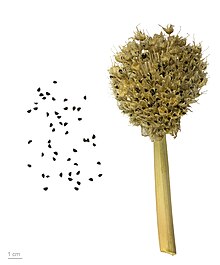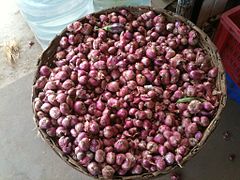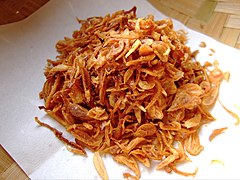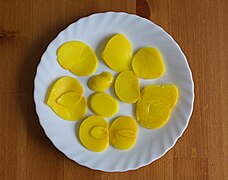Shallot
| Shallot | |
|---|---|
Allium cepa (see text) | |
| Cultivar group | Aggregatum Group |
The shallot is a
As part of the onion genus Allium, its close relatives include
Etymology and names
The names scallion and shallot are derived from the Old French eschalotte, by way of eschaloigne, from the Latin Ascalōnia caepa or Ascalonian onion, a Ascalōnia caepa or Ascalonian onion, a namesake of the ancient city of Ascalon.[5][6][7]
The term shallot is usually applied to the French red shallot (Allium cepa var. aggregatum, or the A. cepa Aggregatum Group). It is also used for the
The term eschalot, derived from the French word échalote, can also be used to refer to the shallot.[11]
Description and cultivation


Like garlic, shallots are formed in clusters of offsets with a head composed of multiple cloves. The skin colour of shallots can vary from golden brown to gray to rose red, and their off-white flesh is usually tinged with green or magenta.[12]
Shallots are extensively cultivated for culinary uses, propagated by offsets. In some regions ("long-season areas"), the offsets are usually planted in autumn (September or October in the Northern Hemisphere).[13] In some other regions, the suggested planting time for the principal crop is early spring (typically in February or the beginning of March in the Northern Hemisphere).[14]
In planting, the tops of the
Nutrition
A raw shallot is 80% water, 17%
| Nutritional value per 100 g (3.5 oz) | |
|---|---|
| Energy | 301 kJ (72 kcal) |
16.8 g | |
| Sugars | 7.87 g |
| Dietary fiber | 3.2 g |
0.1 g | |
2.5 g | |
Niacin (B3) | 1% 0.2 mg |
| Pantothenic acid (B5) | 6% 0.29 mg |
| Vitamin B6 | 20% 0.345 mg |
| Folate (B9) | 9% 34 μg |
| Vitamin C | 9% 8 mg |
| Vitamin E | 0% 0.04 mg |
| Vitamin K | 1% 0.8 μg |
| Minerals | Quantity %DV† |
| Calcium | 3% 37 mg |
| Iron | 7% 1.2 mg |
| Magnesium | 5% 21 mg |
| Manganese | 13% 0.292 mg |
| Phosphorus | 5% 60 mg |
| Potassium | 11% 334 mg |
| Zinc | 4% 0.4 mg |
| Other constituents | Quantity |
| Water | 80 g |
| †Percentages estimated using US recommendations for adults,[16] except for potassium, which is estimated based on expert recommendation from the National Academies.[17] | |
Uses
Culinary
Shallots are used in cooking. They may be pickled. Finely-sliced deep-fried shallots are used as a condiment in Asian cuisine, often served with porridge. Shallots taste similar to other cultivars of the common onion, but have a milder flavor.[18] Like onions, when sliced, raw shallots release substances that irritate the human eye, resulting in production of tears.
Fresh shallots can be stored in a cool, dry area (0 to 4 °C, 32 to 40 °F, 60 to 70% RH) for six months or longer.[19] Chopped, dried shallots are available.[20]
Europe
In Europe, the Pikant, Atlas, and Ed's Red types of shallots are the most common.[citation needed]
Asia
Shallots are the traditional choice for many dishes in Sri Lankan cuisine, including
In most
In Kashmir shallots are widely used in preparation of Wazwan Kashmiri cuisine, as they add distinct flavor and prevent curry from becoming black, which is common with onions.
In Iran shallots are used in various ways, the most common being grated shallot mixed into dense yogurt, a combination served in almost every restaurant when one orders grills or kebabs. Shallots are also used to make different types of torshi (ترشی), a sour Iranian side dish consisting of a variety of vegetables under vinegar, eaten with main dishes in small quantities. Shallot is also pickled—called shour (شور) in Persian—along with other vegetables to be served as torshi.
In
.The tubular green leaves of the plant can also be eaten and are very similar to the leaves of spring onions and chives.
Gallery
-
Shallots for sale in India
-
Shallots being chopped for satay
-
Sliced shallots for bawang goreng in Indonesia
-
Bawang goreng, consisting of crispy deep-fried shallots, is a popular garnish in Indonesia.
-
Pickled shallots
See also
References
- ^ "Shallot". Germplasm Resources Information Network. Agricultural Research Service, United States Department of Agriculture.
{{citation}}:|access-date=requires|url=(help) - ISBN 0-85199-510-1.
- ISBN 978-0-85404-190-9.
- ^ "AllergyNet — Allergy Advisor Find". Allallergy.net. Archived from the original on 15 June 2010. Retrieved 14 April 2010.
- ^ "scallion", at Balashon - Hebrew Language Detective, 5 July 2006. Accessed 28 Feb 2024.
- ^ "shallot". New Oxford American Dictionary (Second ed.). Oxford University Press. 2005.
- ^ shallot. CollinsDictionary.com. Collins English Dictionary - Complete & Unabridged 11th Edition. Retrieved 30 September 2012.
- ISBN 978-1-931686-80-8
- ^ "Spring onions v shallots". 22 January 2013. Retrieved May 14, 2019.
- ^ "Montreal public market site". Montreal public markets. Archived from the original on June 30, 2017. Retrieved August 28, 2014.
- ^ "Dictionary: eschalot". Merriam-Webster, Incorporated. Retrieved December 4, 2013.
- ^ Nolte, Kurt. "Shallot.pdf" (PDF). College of Agriculture and Life Sciences | The University of Arizona. Archived (PDF) from the original on January 22, 2021. Retrieved May 8, 2021.
- ISBN 0-87857-599-5)
{{citation}}: CS1 maint: multiple names: authors list (link - ISBN 978-0-304-29738-2
- S2CID 86748199.
- ^ United States Food and Drug Administration (2024). "Daily Value on the Nutrition and Supplement Facts Labels". Retrieved 2024-03-28.
- )
- ^ "Kitchen Dictionary: shallot". Scripps Networks. Retrieved December 4, 2013.
- ^ "Onions, Garlic, and Shallots". Virginia Cooperative Extension. May 1, 2009. Archived from the original on September 1, 1999. Retrieved March 13, 2013.
- ^ "Shallots, Freeze Dried". McCormick & Co. Inc. 2011. Retrieved March 13, 2013.
- ^ Lopez-Alt, J. Kenji (May 23, 2022). "What Store-Bought Fried Shallots Can Do for You". New York Times. Retrieved January 12, 2024.






